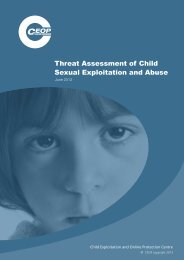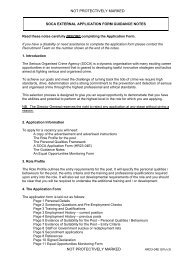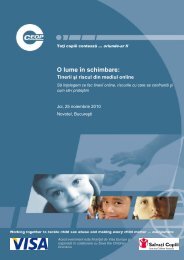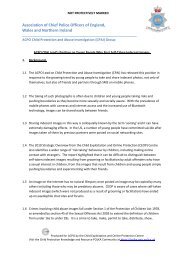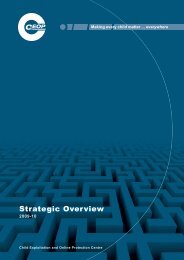The trafficking of women and children from Vietnam - CEOP
The trafficking of women and children from Vietnam - CEOP
The trafficking of women and children from Vietnam - CEOP
You also want an ePaper? Increase the reach of your titles
YUMPU automatically turns print PDFs into web optimized ePapers that Google loves.
NOT PROTECTIVELY MARKED<br />
were exploited for periods exceeding one year. Pacific Links Foundation stated that most<br />
victims exploited in Chinese brothels were aged over 15, although they had documented<br />
cases where the victims were as young as 12. 13<br />
Cases have been identified where poor families have sold their own <strong>children</strong>, commonly to<br />
couples in China. <strong>The</strong>re is a particular dem<strong>and</strong> for male babies in the agricultural regions <strong>of</strong><br />
China, as it is believed that they will be able to generate a better living st<strong>and</strong>ard for their<br />
parents, <strong>from</strong> working the family l<strong>and</strong>. <strong>The</strong> Chinese ‘one child’ policy prevents couples <strong>from</strong><br />
having a second child, if the first is female. <strong>The</strong> dem<strong>and</strong> for male babies is partially met by<br />
<strong>Vietnam</strong>ese mothers selling their babies. Mothers are sometimes driven to this by having to<br />
work <strong>and</strong> thus feeling they were unable to look after their child. 14 In other cases,<br />
<strong>Vietnam</strong>ese girls are sold to Chinese men in order to produce a male baby. Once a son is<br />
born, he is removed <strong>from</strong> the mother who, together with any girl <strong>children</strong>, might be<br />
returned to <strong>Vietnam</strong>, or sold to a Chinese brothel. 15<br />
Trafficking <strong>of</strong> babies internally, as well as externally, has also been recognised as an issue.<br />
<strong>The</strong>re are policies in operation currently which create an environment in which TIP can<br />
flourish, such as paying a commission to orphanages for each baby successfully adopted.<br />
<strong>The</strong>re are also legal difficulties <strong>and</strong> complexities in adopting <strong>children</strong> in countries outside<br />
<strong>Vietnam</strong>, designed to safeguard <strong>children</strong>, which, paradoxically, may encourage would-be<br />
adoptive parents to resort to illegal solutions.<br />
Thai authorities recently uncovered a baby selling ring operating out <strong>of</strong> Bangkok, Thail<strong>and</strong><br />
<strong>and</strong> Phnom Penh, Cambodia. <strong>The</strong>y were connected to a Taiwanese surrogacy service which<br />
pr<strong>of</strong>iled the surrogate mothers on their website. During the investigation, 14 trafficked<br />
<strong>Vietnam</strong>ese <strong>women</strong> were identified as being exploited as surrogate mothers for this<br />
company. <strong>The</strong> <strong>women</strong> were forcibly impregnated with other <strong>women</strong>’s embryos or raped.<br />
<strong>The</strong> service was designed for wealthy Taiwanese couples with the total process costing<br />
$32,000. 16<br />
13<br />
<strong>CEOP</strong> also met a girl trafficked when she was 12 although she managed to escape. Visit to Bac Giang.<br />
MOLISA<br />
14<br />
Conversation with Project Officer, Save the Children, Hanoi, <strong>Vietnam</strong>.<br />
15 Swedish Embassy, Hanoi<br />
16 Phnom Penh Post. 1 March 2011<br />
Page 12 <strong>of</strong> 31



